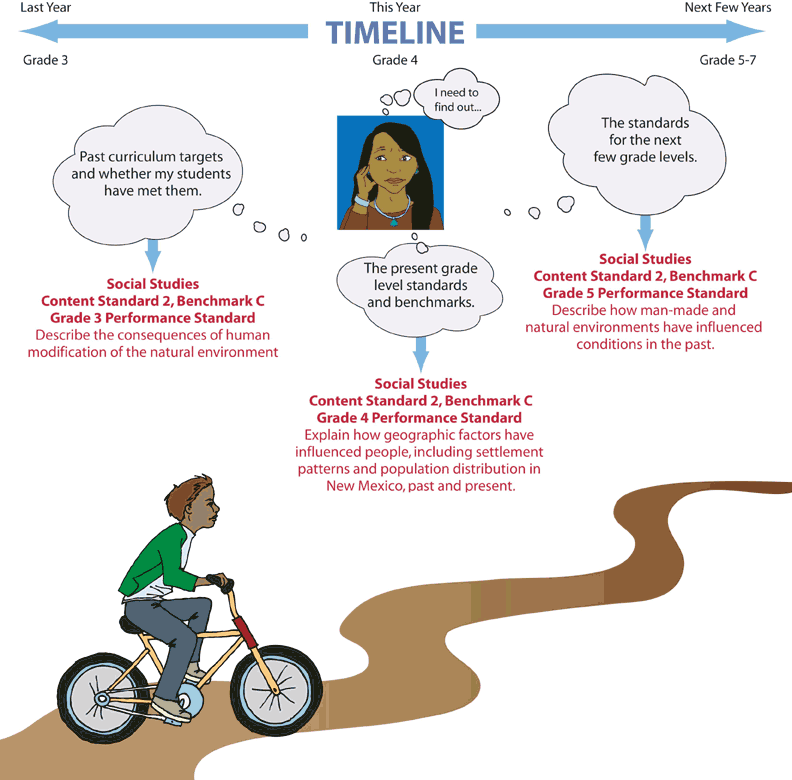How will Ms. Begay know she is teaching her students everything they need to learn this year?
Page 2: Standards-based Curriculum
The standards-based curriculum or the intended curriculum is the official or adopted curriculum contained in state or district policy. A body of content knowledge that students are expected to learn based on their participation within the school experience, standards-based curriculum includes broad descriptions of content areas and often specifies performance standards that students are expected to meet. State and district assessments are linked directly to the content and performance standards contained in the standards-based curriculum. The standards-based curriculum outlines graduation requirements, which are taken from state department of education guidelines that specify the subjects and skills that should be taught at each grade level.
Standards-based curriculum helps teachers to link the taught curriculum to the required standards. It is the connection between the content standards and the taught and learned curriculum.
Taught Curriculum
The daily events that occur in the school community, including all lessons, activities, and social gatherings among peers. The techniques used by teachers during instruction, such as lectures and discussions, are part of the taught curriculum. The term even refers to the style of instruction used by the teacher (e.g., group arrangements, time allocated for instruction, teachers’ personal beliefs and attitudes related to the intended curriculum). Curriculum materials strongly influence the instruction that occurs in classrooms, but the use of curriculum materials varies considerably. In other words, teachers determine the variety of activities and lessons that get taught and how their students will be asked to use the information they receive. Textbooks, worksheets, and electronic media are all examples of curriculum materials that are part of the taught curriculum. However, it should be noted that teachers often mistakenly refer to the school district-adopted textbooks as “the curriculum.”
Learned Curriculum
The information that students learn as a result of being in the classroom and interacting with the taught curriculum is the learned curriculum. This can include information that may not be a part of the standards-based or taught curriculum, something that can be problematic when the learned curriculum includes erroneous or incomplete information. It is important to use assessments that accurately indicate how much of the standards-based curriculum that students have actually achieved.
In order to become familiar with the standards, Ms. Begay must find answers to those questions:
- What domains or areas will be covered?
- What knowledge, competencies, and skills will be attended to?
- What type of learning skills will be required?
She must also see the scope and sequence of the standards and how they expand across the grades. What instructional teaching skills and techniques are necessary for her to effectively teach the required content to her students? She can’t just teach to one grade level. She must be aware of the content her students were taught and expected to learn last year, and she needs to know what her students will be taught in future grades so that she can teach them accordingly. For further illustration of this idea, review the timeline below.

This graphic represents a timeline of Ms. Begay’s thinking about her teaching of content standards. It includes both text and images. At the top of the graphic is the title “TIMELINE,” written in blue bold and all-capital letters. Above this title, in black, is the text “This Year “and below the title is the text “Grade 4.” There is a blue arrow stemming from this title in both directions. On the far left side of the arrow is the text “Last Year Grade 3.” On the far right side of the arrow is the text “Next Few Years Grades 5–7.” Directly below the TIMELINE title is an image of Ms. Begay, who has olive skin and long black hair. She has a concerned look on her face and is resting her head on her hand. There is a thought bubble above her head saying, “I need to find out…” There is a thought bubble to the left of her image, underneath the left arrow that says, “Past curriculum targets and whether my students have met them.” A blue arrow pointing down from this thought bubble states in red “Social Studies Content Standard 2, Benchmark C Grade 3 Performance Standard Describe the consequences of human modification of the natural environment.” There is a thought bubble below Ms. Begay’s image that says, “The present grade level standards and benchmarks.” A blue arrow pointing down from this thought bubble states in red “Social Studies Content Standard 2, Benchmark C Grade 4 Performance Standard Explain how geographic factors have influenced people, including settlement patterns and population distribution in New Mexico, past and present.” The last thought bubble is to the right of Ms. Begay’s images and says, “The standards for the next few grade levels.” A blue arrow pointing down from this thought bubble states in red “Social Studies Content Standard 2, Benchmark C Grade 5 Performance Standard Describe how man-made and natural environments have influenced conditions in the past.” Below all this text is large graphic, spanning the length of the timeline, of a boy wearing a green jacket and gray pants riding this bicycle down a long, winding, brown trail.
English Language Learners (ELL) and Standards Connection
Research increasingly shows that English Language Learners reap more benefits when standards-based curriculum guides classroom instruction. First, it promotes high expectations for all students. Second, standards-based curriculum benefits learning through the practice of building on a student’s prior knowledge to teach new concepts. The new information becomes more meaningful and easier to understand because of the personal connection to the past. Lastly, in standards-based curriculum, the freedom to explore and examine more deeply presented information independently decreases the pressure, frustrations, and fear often associated with learning new information in a non-primary language.